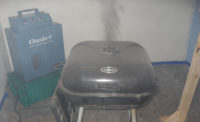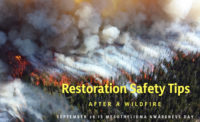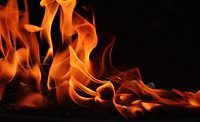During a wildfire, innumerable toxic chemicals, poisonous gases, heavy metals, and other toxins are generated by the materials, household products, and vegetation that burns. These contaminants fill the air, become part of the ash, and are extremely dangerous to your health if inhaled or come in contact with your skin. As restoration contractors, we often forget about the dangers involved in the various environments we enter, but safety should always be a top priority.
If you are entering an area affected by fire or smoke, consider the following safety tips:
- Avoid breathing air contaminated by smoke odor and minimize your exposure to contaminated areas.
- If you need to enter a smoke damaged structure, wear proper personal protective equipment, including a proper fitting respirator with a P-100 HEPA filter designed to filter vapor or gasses (not a dust mask).
- Persons with heart or lung disease should consult their physician before using a mask during post-fire cleanup.
- Avoid handling or coming in direct skin contact with items or materials affected by smoke, soot, or ash. If you need to retrieve items damaged by smoke, wear proper personal protection equipment, such as coveralls, eye protection, gloves, proper foot wear, hardhat, etc.
- Avoid getting ash into the air as much as possible. Do not use leaf blowers or take other actions that will put ash into the air.
- Avoid using shop vacuums and other common vacuum cleaners. These do not filter out small particles, but blow them out the exhaust into the air where they can be inhaled.
- Do not allow children or pets to enter areas that have smoke odor, ash or soot. If children or pets get soot or ash on their skin or hair, wash immediately with mild soap and warm water.
- If you anticipate that you will need to be inside a building or area affected by smoke, attempt to ventilate the area by opening windows or doors unless doing so will allow outdoor smoke odor or ash to get in. Minimize your exposure as much as possible.
- Have an environmental testing laboratory test for Volatile Organic Compounds (VOC’s) and particulates to determine what types and concentrations of toxins may be present. Contact Rarefied Air Environmental for more information at 619-888-4840 or visit www.rarefiedairenvironmental.com. Rarefied Air Environmental can also provide you with a comprehensive smoke odor remediation protocol.
- When sorting through contents, don't take chances. People should not eat or drink anything that has signs of heat or smoke damage. When in doubt, throw it out!
- If you experience any adverse health symptoms from exposure to smoke or soot, seek medical attention immediately.
- If you need to be in an enclosed space that has smoke odor, such as an office, home, or building, try to set up air scrubbers with HEPA filters or other type of filter designed to remove ultra-fine particulate matter as quickly as possible. In addition, using a hydroxyl generator can help to break down odor causing molecules.
For more information and resources on wildfire recovery, visit www.theredguidetorecovery.com or contact Sean Scott at 858-349-2262 or e-mail sean@theredguidetorecovery.com.




Report Abusive Comment